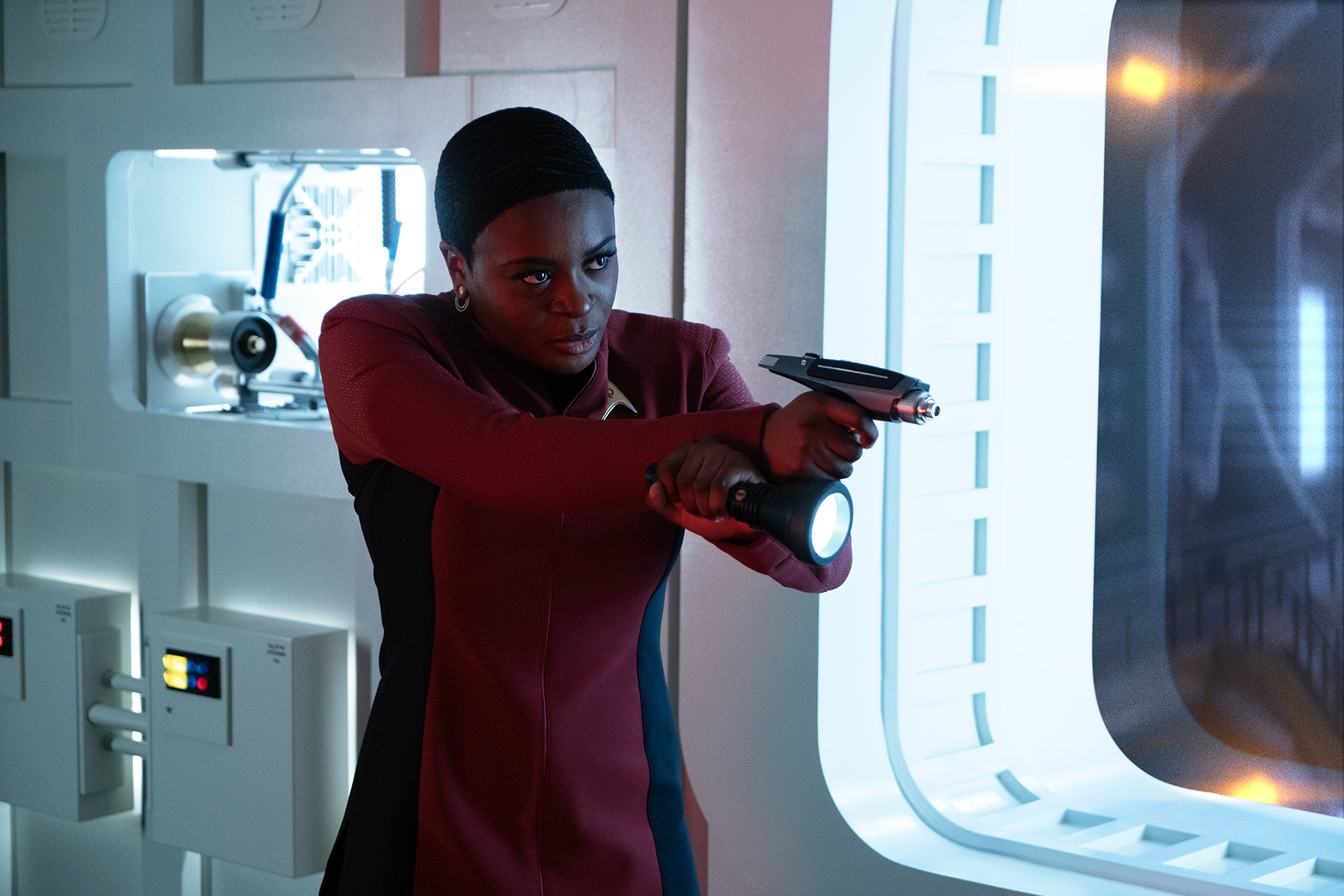
Strange New Worlds S2E6: Lost in Translation
The Enterprise visits an under-construction fuel refinery in a nebula where new stars are being born. The refueling post will be a jumping off point to explore a new section of the galaxy… but also a potential base to defend against the Gorn, a brief acknowledgement that we haven’t seen the last of last season’s recurring villains. While cruising through the nebula, Uhura hears a strange signal… but she can’t seem to play it back for Pike.
She runs a diagnostic on the communications array, using a series of YouTube-like instructional videos left behind by Hemmer, last season’s chief engineer, who sacrificed himself to save the ship. She and Hammer were close, and she lingers on the videos before getting back to work. On the way back to the bridge, she hears the strange noise again, but it’s no signal, it’s in her head. And as soon as she hears it, she sees a terrifying vision of a skeletal Hemmer accosting her.
Dr. M’Benga chalks up the hallucination to deuterium poisoning — the main chemical in the nebula — made worse by the fact that she hasn’t been sleeping. He suspends her from duty until she’s caught up on sleep, but all she can do is toss and turn, still haunted by the vision of her dead friend. When she finally does sleep, she dreams of a green planet with a thick cloud of smoke, emitting the same noises she heard on the ship. We’ve seen enough Star Trek to know this is an alien trying to communicate, but what or why are still a mystery.
Meanwhile, Number One and Pelia are trying to whip the refinery into shape. Construction is behind schedule, everything seems to be breaking down. Pelia suggests there’s some larger issue behind the pattern of neglect; Una coldly dismisses her suggestion. They just need more manpower and some discipline. She’s a hammer, and she only sees the station’s problems as a series of nails. Pelia, unsurprisingly, ignores Una and goes digging on her own. When even the recently-repaired systems have problems, she suspects sabotage.
As for the additional manpower, it comes in the form of the U.S.S. Farragut, and her recently-promoted first officer, one James Tiberius Kirk. His brother Sam gives him the tour, only slightly resentful that the “less handsome brother” has not only been promoted over him, but is the youngest first officer in history. The previous recordholder was their Dad, and Sam’s worried the paterfamilias looks down on his more modest career as a xenobiologist, but for the moment is taking those feelings out on his golden boy brother.
Spock and Chapel share smoldering glances over 3d chess, until he tries a relationship gambit: he tells Chapel they should notify Starfleet of their relationship (as they have a policy on fraternization), as a way of pressing her on what their relationship actually is at this point. But she’s reluctant to put a name on things — she compares their unquantifiable relationship to Schrodinger’s Cat. Open the box, and it might die.
They’re interrupted by Uhura, who seeks Spock’s advice on her hallucinations. They predated her exposure to deuterium, and she thinks something else is at play, but he insists the doctor’s diagnosis was the logical one: exposure to a known hallucinogen causes hallucinations, QED. Kirk lends a more sympathetic ear, but his reputation precedes him. “I really don’t want to be hit on right now.” She steps out into the hallway, to find the lights off, bodies of the crew strewn everywhere, and standing over them with a bloody knife… herself.
She takes a swing at her doppleganger, and ends up giving Kirk a bloody nose. But he’s more intrigued than hurt — he’s had deuterium poisoning, he’s had insomnia, and neither gave him hallucinations like the ones Uhura’s been having. He resolves to help, and frankly, “something strange is happening and only one person believes me” is a big improvement over the classic TV trope “something strange is happening and I refuse to tell anyone in the interest of advancing the plot.”
The plot also advances on the refinery, as Number One quickly tracks down the saboteur, a terrified-looking Lt. Ramon, huddled in a corner whispering, “it isn’t real. It isn’t real.” He’s a crew member of the Farragut, and Kirk quickly connects his symptoms with Uhura’s. When M’Benga checks him out, Ramon’s symptoms are more advanced than Uhura’s — whatever’s happening to them has damaged the speech and language sections of Ramon’s brain, and it’s getting worse. He and Uhura both hear the noise again, and Ramon panics, fighting his way out of sickbay with Pike in pursuit.
Uhura and Kirk join the search, but she hears the noise again, more insistently this time, and suddenly Kirk’s gone and the walls are closing in on her. Kirk rouses her from the hallucination, and against his better judgment lets her walk back to sickbay alone, and armed, while he continues the search, and the audience yells “never split up during a horror movie!” at their TVs.
Naturally, she’s the one who finds a blood trail leading to an access tube, and before you can shout “don’t go in there” at your TV, she’s ignoring Pike’s order to wait for him and crawling through the tube. She confronts Ramon on the other side, hoping he’ll empathize with a fellow hallucination-sufferer, but he’s too far gone. And Uhura realized she’s only a few days away from being in the same condition.
Of course the mystery is solved, and the reason behind it all will be as obvious to most viewers as the clichéd horror movie blunders the crew fall into. But as with last week’s disapproving-mother-in-law farce, Strange New Worlds can overcome a flimsy premise because, even when it doesn’t do anything new, it does it really, really well.
For one, when the show uses an episode to spotlight one character, they don’t waste the moment. Before the story wraps up, Uhura — fearing her condition is going to continue to degenerate into madness — confesses to Kirk why she was so affected by Hemmer’s death. Her family was killed in a shuttle accident, and she never fully processed their deaths. She was so haunted by images of the crash that she struggled to put them out of her head, and never fully mourned them. It’s a terrific acting moment from Celia Rose Gooding, and her taking a moment to mourn Hemmer is what sparks her to come up with a solution to what’s behind her hallucinations. Instead of taking us out of the story for an emotional moment, it ends up being a catalyst to push the story over the finish line.
It’s that combination of things — smart plotting, emotional resonance, a winning cast playing well-drawn characters — that makes the show work so well. Even in a lesser episode, Strange New World’s Enterprise is always firing on all cylinders.
Stray tachyons:
• Uhura’s light-up earrings are a very cool bit of 24th-century costume design.
• Like many characters on Strange New Worlds, Sam Kirk was introduced on the original Star Trek, appearing in a handful of first-season episodes. But by late-season episode “Operation — Annihilate!” he’s dead, of a planet-wide parasite infection that kills him and his wife, but spares their son. One of the perils of a prequel is getting to know someone who — like Pike, or Spock and Chapel’s relationship — is doomed from the start.
• Paul Wesley is as charming as always as James Kirk, but we can’t help but thinking that Spock, Chapel, or La’an could have been the one to help Uhura. Strange New Worlds has such a strong cast, it seems like a shame to sideline them for the sake of our most fanservice-y guest star, so soon after the Kirk-centric “Tomorrow and Tomorrow and Tomorrow.” We could use a much longer season of SNW for a lot of reasons — mainly that the show is great and we want more of it — but also so it doesn’t feel like the main cast is getting short-changed. For instance, we barely see Pike or Ortegas this week, and La’an only shows up when it’s time for her to have a moment with Kirk.
• That being said, it’s a nice moment. She doesn’t try and explain the events of “Tomorrow,” in which she found herself falling for a version of Kirk in an alternate timeline. Instead, he explains his impulse to help Uhura moments after meeting her, and she reassures him that, as someone who owes her life to strangers risking themselves to save her, she understands. It’s a nice moment that underscores why they’d be good together in any timeline, without trying to force “Tomrrow”’s relationship back into the storyline.
• The frequent talk of sabotage in the episode (and the use of the Beastie Boys’ song of the same name in the recent films) is a reference to William Shatner’s refusal to pronounce the word correctly on the original series. “You say sabotage. I say sabo-taazh.”
• Una derisively refers to Pelia as a “space hippie,” also a reference to the original series.
More From Subject
The Umbrella Academy S4E6: End of the Beginning
Tolstoy suggested that all happy families are alike; all unhappy families are unhappy in their own way. This, not super-powers,...
The Umbrella Academy S4E5: Six Years, Five Months, Two Days
So last week, Five and Lila got very, very lost, on the metaphysical subway that connects the show's disparate timelines....
A Letter to Insomnia
Dear Insomnia, The older I get, the more I understand you. The way you are able to exploit the intensity...
Real Talk: Clingy Parents, Back-to-School Blues, and Roommate Anxieties
Welcome to Real Talk, Subject’s advice column with UB alumna Savannah Johnson. Each month, Savannah dives into your burning questions...
What’s Good – September 5-11, 2024
Our weekly guide to what's going on around Buffalo and in the world of pop culture. Thursday, 9/5 Jason Ellis (Helium,...
The Umbrella Academy S4E4: The Cleanse
At the end of last episode, an alternative-timeline version of the Hargreeves' estranged father hooked them up to a machine...
